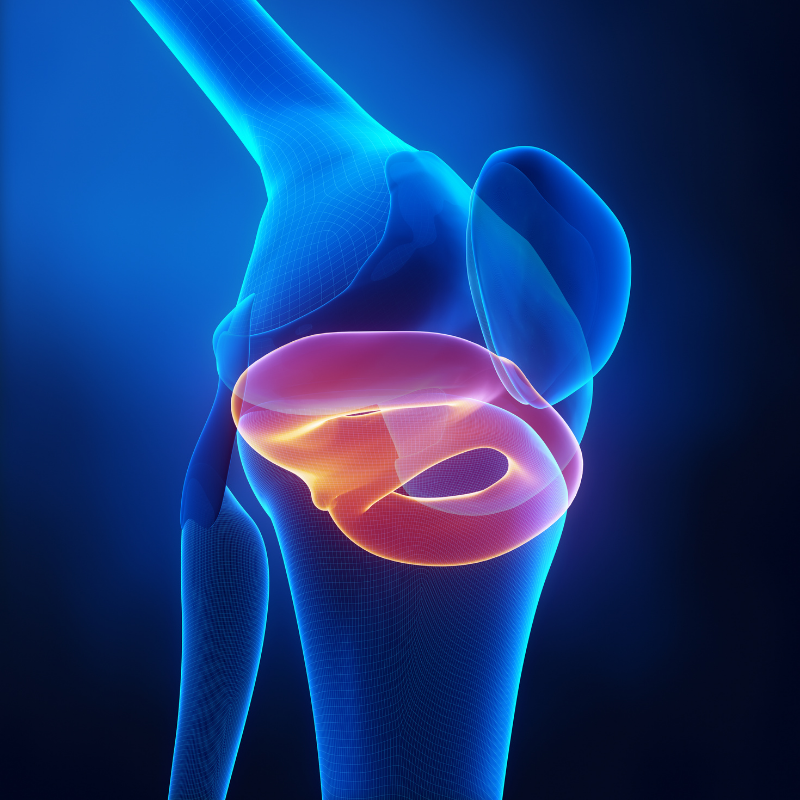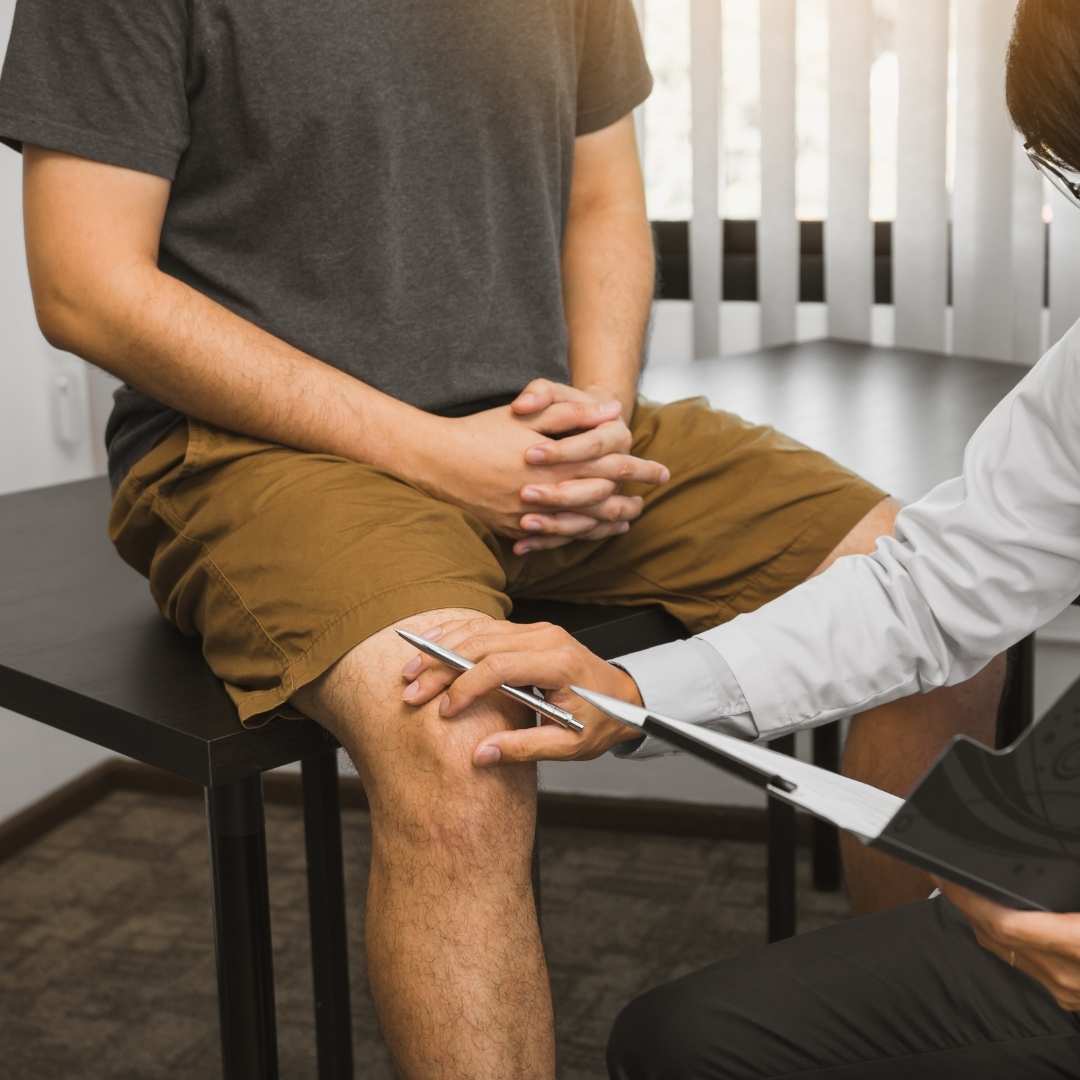Precision and Expertise in Meniscus Tear Treatment
WHAT IS THE MENISCUS?
The meniscus is a ‘C’ shaped piece of tissue that sits on top of the shinbone (tibia) and acts as a shock absorber in the knee. There is a meniscus on the outer (lateral) aspect of the knee and one on the inner (medial aspect).
WHAT DOES THE MENISCUS DO?
Each meniscus acts as a shock absorber transferring force from the thigh bone (femur) through the knee to your shinbone (tibia). The meniscus also helps stabilise the joint.
HOW IS THE MENISCUS TORN?
There are two main groups of meniscal tears.

DEGENERATIVE
Degenerative tears occur when the joint surface is no longer smooth and the meniscus gets trapped between the two surfaces and tears. As part of the normal ageing process, the meniscus can become less elastic and tear. Generally, these are not caused by a specific injury. The majority of degenerative tears can undergo non-operative treatment.
ACUTE
An acute tear occurs with an injury. Common causes:
• Sudden change in direction
• Twisting
• Landing awkwardly
• Associated ligament injury.
An acute tear can occur in the presence of age related changes, but this can make it more difficult to predict outcomes.
COMMON SIGNS AND SYMPTOMS
Patients often present reporting the following:
- Knee pain
- Knee swelling
- Clicking and catching
- Reduced range of movement particularly being unable to fully straighten the knee
HOW IS A knee meniscus injury DIAGNOSED?
The vast majority of knee meniscus injuries can be diagnosed from asking you specific questions and performing a physical examination of the knee. X-rays are helpful to assess the degree of degenerative changes within the knee. An MRI scan can be helpful to locate the degree and area of the tear and look for associated injuries.
WHAT ARE THE TREATMENT OPTIONS?
Treatment options depend on a number of factors listed in the next section.
NON-SURGICAL TREATMENT
Most people with a degenerate tear to the meniscus will find their symptoms improve with a good rehabilitation programme. If your knee is causing mechanical symptoms that stop you from doing your normal activities, surgery may be an option.
SURGICAL TREATMENT
The aim of surgery is to restore function and relieve symptoms. Some meniscal tears can be repaired, others require the damaged portion to be removed. This is often decided at the time of surgery.

HOW TO DECIDE ON treatment for a meniscus tear?
Deciding what treatment is fit for you can be difficult and will require a discussion with your torn meniscus surgery expert, Mr Webb, and/or your therapist. Mr Webb always tries to restore anatomy by repairing meniscal tears wherever possible.
Factors to take into account are:
- The type of tear
- The location of the tear
- The duration of symptoms
- If there are associated ligament injuries
- Other medical conditions
- Current lifestyle/activities
- Expectations.
Factors to take into account are:
- The duration of symptoms
- Response to rehabilitation
- Activity and lifestyle changes
- Expectations.
WHAT DOES meniscus surgery INVOLVE?
Meniscus surgery is usually performed under general anaesthetic. A small camera is used to look around the entire knee and address any other problems that may be present. The meniscus is then examined and it is determined if the tear can be repaired and what type of repair is appropriate. If the tear cannot be repaired, the damaged portion is removed. The procedure takes less than an hour in most cases.
What You Want To Know About Our Meniscus Tear Surgery
What happens before Meniscus Surgery?
CONSENT:
It is important that you understand the potential risks of surgery as well as the benefits. You will have the opportunity to go through these with Mr Webb. Prior to the procedure, an electronic consent form will be sent to you that goes through the risks in detail. Please do not hesitate to arrange an appointment to discuss any questions you have.
PREHABILITATION:
If this is an acute tear, Mr Webb advises that you start a physiotherapy programme soon after your injury. If you have a degenerative tear, it is still worth seeing a therapist before surgery.
The aims of prehabilitation are:
- Reduce swelling
- Improve range of movement
- Muscle strength
- Practice using crutches
What happens on the day of Surgery?
You will be asked to come to hospital where one of the nursing staff will prepare you for the procedure. The anaesthetist will meet you to discuss the type of anaesthetic and pain relief plan for after. Mr Webb will confirm the details of the procedure with you, answer any last-minute questions and draw an arrow on your leg. The procedure normally takes less than 1 hour. Once you have recovered from the anaesthetic, you will get up with your crutches and practice walking. The vast majority of patients go home a few hours after their operation.
Mobility
Meniscus repair
You are likely to require crutches for 4 to 6 weeks and sometimes will be placed in a knee brace to protect the knee. The brace will allow bending from straight to 90 degrees.
- Week 0 – 4 — You will use crutches and you will be allowed to put 50% of your body weight through the operated leg.
- Week 4 – 6 — You will now start to put your full weight through the leg and wean off the crutches as guided by your therapist.
Removal of the damaged meniscus (meniscectomy)
You will be given crutches to help mobilise, but you can put all your weight through your leg and wean yourself off the crutches as comfort and common sense allows.
What are the risks of Meniscus Surgery?
It is important to discuss the risks to ensure that you can assess whether surgery is right for you.
The specific risks for meniscus surgery include:
- INFECTION — this risk of infection is less than 1 in 500 cases. Antibiotics are not routinely used unless a repair is performed and is given during the anaesthetic.
- BLOOD CLOTS — the risk of developing a blood clot is approximately 1 in 1000. Clots in the leg (Deep Vein Thrombosis/DVT) can travel to the lung (Pulmonary Embolus/PE).
- PAIN — people can experience pain following surgery. This is mainly dictated by the degree of damage within the knee.
- STIFFNESS — It is important to follow a rehabilitation programme.
- RE-TEAR — A repaired meniscus can tear. Factors that increase this risk are increasing age, length of time from injury, the tear pattern and an unstable knee.
What happens after Surgery?
It is normal to have pain and swelling following a knee arthroscopy. There are cold therapymachines available to help reduce the swelling. It is a good idea to see your physiotherapist within the first week following your operation. At approximately two weeks, you will be seen by Mr Webb to review the incisions and go through the details of what was found and performed.
There are cold therapy machines available to help reduce the swelling. It is a good idea to see your physiotherapist within the first week following your operation. As mentioned above, one of the risks of the procedure is nerve injury. It is normal to have some numbness and this usually improves within the first couple of weeks. At approximately two weeks, you will be seen by Mr Webb to review the incisions and go through the details of what was found and performed.
Dressings and Wound Care
You can remove the bandage after 24 hours. The sticky dressings should remain on until the two week review even if blood stained. If they do come off they can replaced by any simple waterproof
dressing. If the waterproof dressings are intact you can shower, but do not soak the dressings and be careful not to slip or put too much weight through the operated leg.
After your two week review, you can have a bath or swim.
Don't Let Your Knee Pain Define You:
Treating Knee Meniscus Injuries with Expert Care.
Is your child feeling burdensome to hold? Do clicking or popping sensations in your knee joint make simple errands unbearable? Swelling and pain while walking? These could be symptoms related to knee meniscus issues. The meniscus between the thigh bone and shinbone acts as a shock absorber, providing stability and cushioning during movement. Injuries to the meniscus can result in tears, causing pain, swelling, stiffness, and limited mobility. Treatment options range from conservative measures to surgical interventions like arthroscopic meniscus repair. We understand the impact of knee meniscus injuries on your life. With expertise and compassion, Dr Mark Webb and his team offer unwavering support on your journey to recovery.
Watch the Procedure
